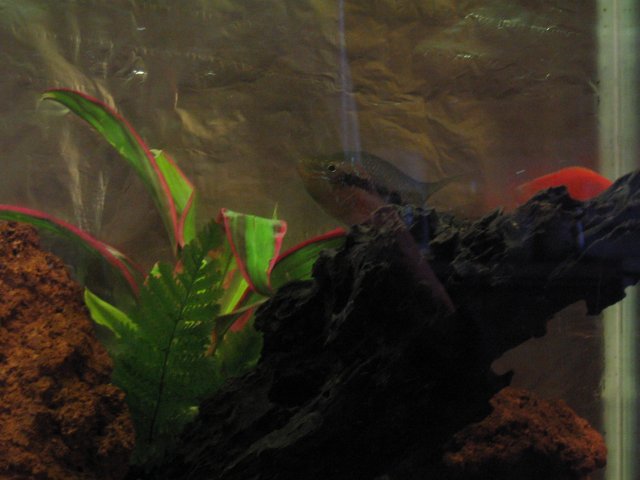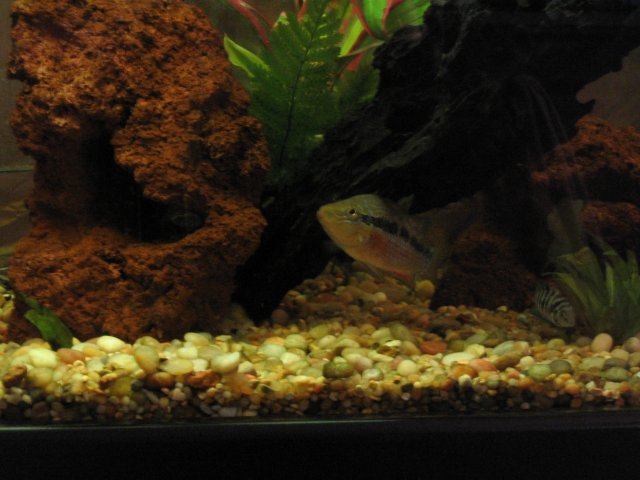here's an article i wrote on C. salvini for another source. you may better understand this fish after reading it.
Cichlasoma salvini
A beautiful jewel from southern Mexico, Cichlasoma salvini is perhaps inch for inch and ounce for ounce, the most aggressive and pugnacious little cichlid ever to inhabit an aquarium. Some die hard cichlidophiles such as myself will tell you that the aggression exhibited by this fish is just one of its many fascinating behaviours, but i'll also tell you that this fish is not for everyone.
Cichlasoma salvini is found in the tropical forest jungle areas of Mexico, Belize, Guatamala and into Honduras. It inhabits rivers and lagoons which are heavily shaded by the huge trees and abundant vegetation throughout this habitat. The aquatic bottom is covered with leaf litter and tree branches and the water has low visibility. Water chemistry is always alkaline with pH ranging from 7.7- 8.4 or higher. Hardness is quite variable, ranging from a DH of 8° to greater than 50°.
C. salvini grows to a maximum of 7 inches (males) and females to about 5 inches. Both males and females display a bright golden yellow base color blending with reds and shades of yellow. Females exhibit brighter, bolder colors than males, primarily on dorsal and ventral areas, which are replete with red colors fluctuating in intensity and size depending on the geographical variant. Males have a ventral area which shows just a hint of this red coloration but have beautiful blue spangling on the dorsal area above the lateral line and blue streaks on the head. Females can be easily differentiated from males on the basis of a blue-edged black blotch on the middle portion of the dorsal fin. Breeding colors in both males and females begin with an intensifying of the base yellow color, diminished blues and a blackening of the dorsal area from upper lip to as far back as the caudal peduncle along the lateral line.

Despite its relatively small size, in its natural habitat C. salvini displays extraordinary aggression levels and a single pair of spawning cichlids will defend a territory 6 feet or larger in diameter against all comers no matter how large. This is all the more incredible given the wide variety of large and belligerant cichlid species with which salvini is found sympatric. These may include the Theraps species, Vieja species, Amphilophus species, the piscavorous Petenia splendida, Nandopsis urophthalmus and the Guapotes of the Parachromis group, most notably the managuense. Evidently, the intense and supremely brilliant coloration of salvini is most often sufficient to dissuade other fish from getting close to them. That failing however, salvini will make quick work of any predator which gets too near it's territory.
Cichlasoma salvini in your tank? The primary consideration in keeping this species is successful management of their aggressiveness. Salvini exhibits a special animosity towards individuals of their own species which means no more than one male in the tank. That tank needs to be at least 5 feet in length ... the farther apart you can keep the fish in this tank, the better. In my experience, smaller tanks almost always result in death of subordinate individuals such that you end up with that single male again. So how will you breed this little jewel? My suggestion is to start out with a group of 6-8 juveniles and allow a single pair to form. Once pair formation is complete, quickly remove all unpaired salvini or they will be summarily 'removed' for you by the dominant pair.
Additional means of aggression control can include the use of other, larger species as tank mates. Those sympatric species mentioned above are excellent choices. C. salvini shows a great tolerance for fish which are too large to be eaten, and will virtually ignore them outside of spawning time. An abundance of cover is also important ... many caves and hiding places which will afford other fish the opportunity to 'disappear from view'.
Spawning in the aquarium. The preferred biotope for this cichlid is an abundance of driftwood and rocks over a fine gravel substrate. Despite the presence of caves, my salvini have always picked a vertical piece of wood to lay their eggs on. Several hours are required for completion of the egg laying process, the reason being that salvini typically lay about 500 eggs. This is a throwback to the fact that in the wild, salvini need to keep their population density constant .. no small task given the extent of the danger which fry and juveniles encounter during development. Complete batches of eggs are lost due to unexpected heavy rains during the spawning season, producing strong currents which may wash the fry away. Couple that with the plethora of predatory species which both fry and juveniles will encounter in their habitat and you can understand the tremendous expenditure of energy that salvini requires in order to thrive.
Is this a cichlid for you? If you take the time to understand the behaviour and needs of this beautiful cichlid, its aggression can be managed. Provide it with the space it requires to exhibit normal behaviour and the results can be very rewarding.






